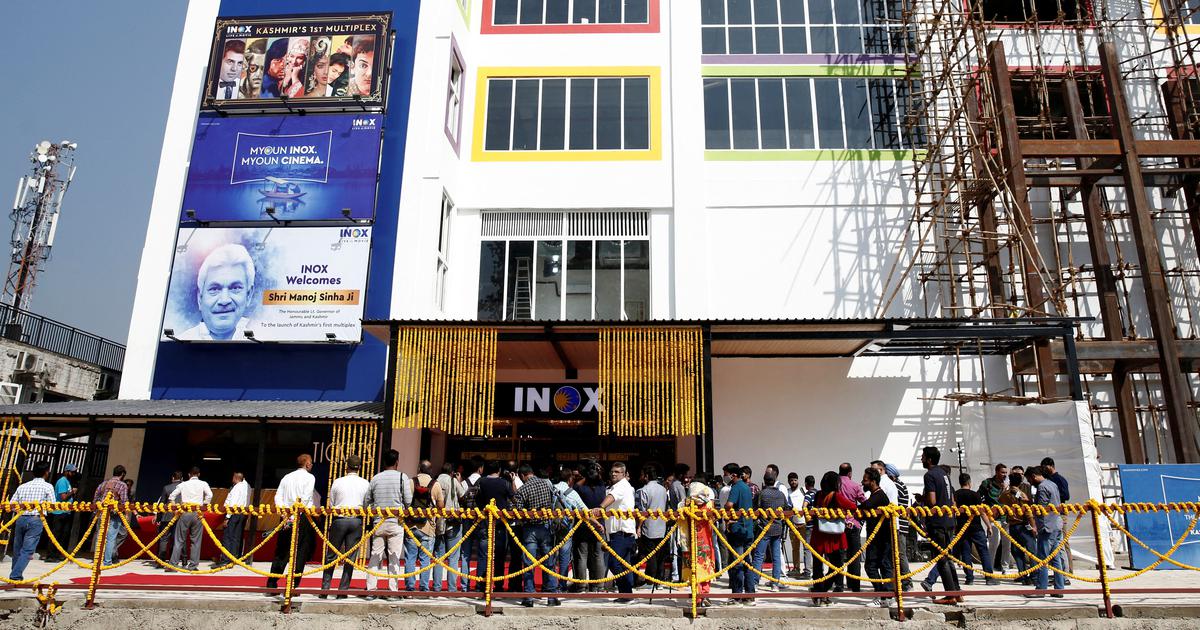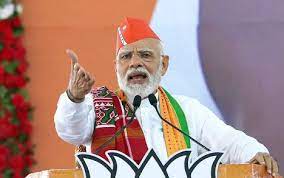
Kashmir got its first multiplex last month – but who is watching?
By: Safwat Zargar
Had it not been for the Central Reserve Police Force posted outside, visitors might have missed the entrance to Kashmir’s first multiplex, inaugurated on September 20. Like other protected establishments in Kashmir, the brand new Inox multiplex’s gates are shut, watched over by a security checkpoint. Only when a vehicle or a person turns up do the gates slide open.
Shivpora, where the movie theatre is located, is one of the most high-security zones in Kashmir. Across the main road leading into posh Shivpora is Badami Bagh Cantonment, headquarters of the Indian Army’s 15 Corps. There are two more security checkpoints within the gates of the multiplex. The personnel of a private security agency have been employed to do the security checks. Policemen and paramilitary troops deployed within the premises of multiplex oversee the process.
Visitors are sparse on the ground. On October 8, a Saturday evening, a group of 50-odd Tamil students from a university in Kashmir, were watching Ponniyin Selvan: 1, Mani Ratnam’s opulent historical drama, starring Aishwarya Rai Bachchan, among others. Other visitors included a bunch of students from Kargil, a group of women tourists and some local Kashmiri students. Only about 30 people streamed into the third hall, which can seat 223.
The film playing here was Vikram Vedha, starring Saif Ali Khan and Hrithik Roshan. The film has a painful resonance in Kashmir, witness to regular gunfights between security personnel and militants. The Hindi version of a 2017 Tamil action thriller, it depicts a trigger-happy policeman heading a “Special Task Force” to eliminate a dreaded gangster. As the movie progresses, it ventures beyond the binaries of good and evil into a layered debate about moral relativism. There is no difference between a lawmaker and a lawbreaker, it seems to suggest. “I didn’t like the movie much but I just wanted to experience it,” said a local college student in her early 20s after the film was over. A generation in Kashmir has never been to the movies.
Peace offering
When Jammu and Kashmir Lieutenant Governor Manoj Sinha inaugurated the hall, he called it part of the “major socio-economic revolution” that had swept through Jammu and Kashmir in the last three years. This was a reference to the legislative changes of August 5, 2019, when the Centre revoked formal autonomy for Jammu and Kashmir under Article 370 and split the former state into two Union Territories, directly administered by Delhi. “Peace is to be established, not bought,” Sinha said in his inauguration speech. Lal Singh Chaddha, starring Aamir Khan and partly shot in Kashmir last year, was then screened at the inauguration.
But public response to the theatre hall has been lukewarm, at best. A joint venture between Inox and an influential Kashmiri Pandit business family, the multiplex can seat 522 people. The movie hall was opened to the public on September 30. “The first day witnessed heavy footfall because the owners had decided to give free passes,” said a staff member at the multiplex. “It was really difficult to manage such a crowd.”
The theatre opened for commercial operations on October 1 and the crowds have been thin. From October 1 to October 9, the multiplex had several shows a day, playing to a total of 18,000 seats. But tickets were sold for only 12% of them, he said. Weekends and evening shows did better business. Many of the audience were tourists and youth from other states who study in Kashmir, he added. There are no late-night shows because of security concerns. “We have to wrap up by 9:45 in the evening because we don’t have security clearance beyond that,” explained the member of staff.
Film fever
There was a time when Kashmir was mad about movies. The first-ever cinema hall in the Valley, Palladium Talkies, was built in 1932 in Lal Chowk in the heart of Srinagar. The theatre was owned by Bhai Anant Singh Gauri, a Punjabi-speaking Sikh businessman and a philanthropist.
According to historian Khalid Bashir Ahmad, the 1960s saw a rapid expansion of cinemas in Kashmir. These were not confined to Srinagar. They cropped up in districts like Anantnag in the south and Baramulla in the north. Besides, there were cinemas run by the army into which civilians would also be allowed. Older residents of Kashmir recall poring over local dailies to check for new movies and when they would be played.
“Such was the craze that we would save money for days to buy a ticket,” recalled 52-year-old Feroz Ahmad, a movie buff from Srinagar’s downtown area. “We wouldn’t mind if it was a late-night show or if there was no transport available to go home. We would walk home, discussing the film.” The cinemas were not just about the movies. It was also a place for engaged couples or lovers to steal a few moments together, away from prying eyes. Little wonder, then, that cinema-going was frowned upon by a section of Kashmiri society. These taboos were reinforced as militancy started spreading across the Valley in 1989.
A grim curtain call
It was curtains for cinemas in Kashmir after a militant group called the Allah Tigers ordered all movie halls and liquor shops to be closed. Some theatre halls were attacked and set alight to show that the group meant business. “In 1989, when cinema was banned in Kashmir, there were at least 15 functional cinemas in the Valley, nine in Srinagar city alone,” writes Bashir.
By January 1990, all movie theatres were shut in the Valley. Palladium Cinema was gutted by a fire in 1990 and the charred remains of the theatre still serve as a security checkpost today. Over the years, it has seen two attacks targeting the checkpost. As the insurgency grew, many of these abandoned theatres were turned into shelters for security forces or “interrogation centres”.
The militancy and subsequent crackdown by the Indian state also dramatically changed public life in Kashmir. People chose to stay indoors or hurried home before dusk. The concept of a night-life vanished and a sense of uncertainty hovered over every aspect of life. Towards the end of the 1990s, with militant groups on the backfoot, the government tried to revive cinemas in the valley. But the effort was short lived.
In September 1999, Regal Cinema in Srinagar was reopened for screenings of Pyar Koi Khel Nahi, starring Sunny Deol and Mahima Choudhary, but militants attacked the first day, first show, killing a civilian and injuring 12 others. Earlier, the National Conference-led state government had reopened two more cinemas in Srinagar. To encourage the trend, the government had offered interest-free loans for renovation to would-be cinema owners. But the grenade attack on Regal cinema put a stop to those efforts. Today, a major intersection in the centre of Srinagar is still called Regal chowk, but the cinema hall after which it was named is long gone.

